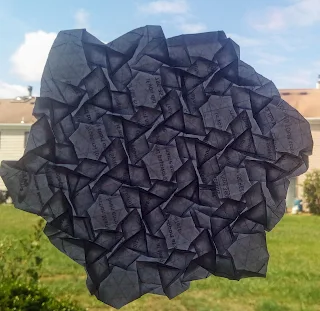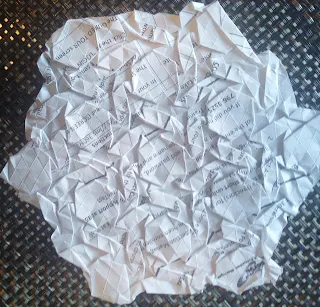Flagstone Variation
I saw this one on flickr. I don't know the original designer to credit.
I thought it might be fun to fold. Turned out to be a little more difficult than I had anticipated.
It was terribly difficult to put together. Still, once I started, I was determined to complete it.
There are some open back hexes. They've got rhombuses off of them. Those rhombuses are tethered to triangles.
Interesting part is the triangles are natural to the grid. Which isn't typical .
The rhombuses land in triads off of those triangles.
Nothing really works on its own. Everything depends on everything else. It's a whole lot of getting folds to sort of stay while you get the rest of the folds to also sort of stay as you work your way out from the center.
It looks and fold like a flagstone, but it's not a true flagstone. You might call it a flagstone variation. There are a lot of similarities.
When everything is kind of willing you start again moving everything into place together. Rinse and repeat until it's all been convinced.
The triangles are the key. When you twist them into place and get the rhombuses to follow suit it all begins to coalesce.
At first, I wasn't sure what direction to go with the triangles. But they need to be on top.
I really like the how the rear backlights. That's shown in the first image.
The second image is the front backlit. It's nice, but I prefer the rear view.
I've also included the unlit versions for clarity. Front first and then rear.
I thought it might be fun to fold. Turned out to be a little more difficult than I had anticipated.
It was terribly difficult to put together. Still, once I started, I was determined to complete it.
There are some open back hexes. They've got rhombuses off of them. Those rhombuses are tethered to triangles.
Interesting part is the triangles are natural to the grid. Which isn't typical .
The rhombuses land in triads off of those triangles.
Nothing really works on its own. Everything depends on everything else. It's a whole lot of getting folds to sort of stay while you get the rest of the folds to also sort of stay as you work your way out from the center.
It looks and fold like a flagstone, but it's not a true flagstone. You might call it a flagstone variation. There are a lot of similarities.
When everything is kind of willing you start again moving everything into place together. Rinse and repeat until it's all been convinced.
The triangles are the key. When you twist them into place and get the rhombuses to follow suit it all begins to coalesce.
At first, I wasn't sure what direction to go with the triangles. But they need to be on top.
I really like the how the rear backlights. That's shown in the first image.
The second image is the front backlit. It's nice, but I prefer the rear view.
I've also included the unlit versions for clarity. Front first and then rear.









Comments